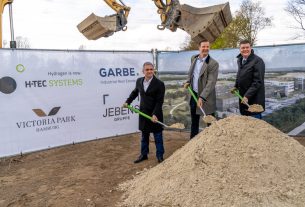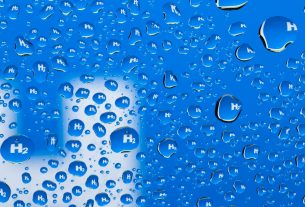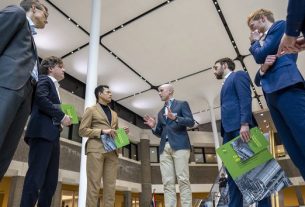The Netherlands – The Dutch government wants a national transport network for hydrogen. It is a task with which Hynetwork Services will be working. The next step for this 100% owned subsidiary of Gasunie is to connect five large industrial clusters in the Netherlands. ‘It is now important that we get a market going,’ says project director Eddie Lycklama à Nijeholt. He is one of the guests on stage at EIES2021.
The construction of an infrastructure for hydrogen requires a sober outlook. It’s not all that new or technically complicated, says Eddie Lycklama à Nijeholt, Hydrogen Backbone Netherlands programme manager at Gasunie. Until sixty years ago, town gas was an important energy carrier in Europe. ‘Soon, half of it consisted of hydrogen’, he says. In the Netherlands, the gas plants in which the mixtures of hydrogen, methane and carbon monoxide were produced disappeared with the advent of natural gas.
And it is precisely the natural gas infrastructure that was built at that time that currently offers a springboard for the resurgence of hydrogen. Lycklama à Nijeholt: ‘In order to connect the five large industrial clusters in the Netherlands to each other, approximately 1200 kilometers of pipeline is needed. More than a thousand kilometers of existing infrastructure can be used for this. That already prevents a lot of inconvenience to the surrounding area. Think of it as a freeway that needs to be renovated. We’re only replacing the top layer.’
50 bar
After disconnecting part of the natural gas infrastructure, only a limited number of adjustments are required. ‘Of course we inspect the pipes and replace parts where necessary. We also clean them and we have to replace valves. But with hydrogen, unlike with natural gas, you don’t need a valve every ten kilometers, but no more than every eighty kilometers. So that already saves money.’
Because the molecules of hydrogen are lighter than those of natural gas, no extra compression is needed en route in the Netherlands. The pressure that is added at the import can even be lower than for natural gas. And even then, hydrogen travels through the pipe about three times faster. Lycklama à Nijeholt: ‘Natural gas is pressurized to 66 bar. Hydrogen will have a pressure of 50 bar when it is imported. That is enough to leave 30 bar at the border with Germany. That is sufficient. If we are going to export hydrogen, we may need extra compression at the border.
Hydrogenation
Gasunie has been appointed by the Dutch Ministry of Economic Affairs to build a hydrogen infrastructure in the Netherlands, the so-called backbone. Gasunie has accepted the challenge. However, it is doing so under a different name and legal entity. Gasunie was originally set up to transport natural gas. If we want to transport hydrogen or, say, CO2, we will have to set up other organizations to do that. For CO2, for example, that is Porthos, among others.’
For hydrogen, the new entity is Hynetwork Services. ‘Earlier we established this one hundred percent subsidiary for transporting hydrogen between Dow in Terneuzen and Yara in Sluiskil.’ Since the end of 2018, the two chemical companies have been exchanging hydrogen via a Gasunie gas transport pipeline that is no longer in use. The establishment of a new entity is therefore no longer necessary. Within Hynetwork Services we will also roll out the backbone.’
This immediately reveals the sequence of the first steps that Hynetwork Services is taking. Lycklama à Nijeholt: ‘First of all we are investigating within large industrial clusters how we can link together the supply and demand of hydrogen. Like at Dow and Yara. If one of them has too much, we can take it to another that can use the hydrogen. Several industrial clusters are already working on a regional hydrogen infrastructure.
The next step is to do the same nationally. The construction of the so-called backbone, the backbone of the future hydrogen network. ‘That means we are going to focus on connecting the five major industrial clusters.’ These are the port of Rotterdam, Amsterdam region, the North Seaports area (Zeeland and Ghent), the Eemsdelta in the north and Chemelot in the south.
It seems no more than a logical step. There is already a great deal of demand for hydrogen in the process industry, for example for the desulphurization of fuels and the production of artificial fertilizer. And new developments will soon require hydrogen as well. Think of the chemical recycling of waste plastics. Hydrogenation seems to be the appropriate route to remove chlorine and phosphorus from the streams, for example.
Electrons
The puzzle around Chemelot is special. The other four clusters are located by the sea, close to existing and future offshore wind farms. The production of green hydrogen will be easier there. Moreover, there are also more opportunities for blue hydrogen there. CO2 can be stored nearby in exhausted gas fields. Chemelot and also large German industrial clusters a little further away are less favorable in that respect. It is even being investigated whether CO2 from Limburg and Germany can be transported to the North Sea. That, of course, is also possible. ‘However, the more hydrogen you bring to Chemelot, the less CO2 you have to transport.’
Chemelot and also the German chemical companies are therefore investigating more options. Not for nothing is the turquoise route receiving more attention there. Via methane pyrolysis, hydrogen can also be produced from natural gas with carbon as a second product. Large-scale supply of natural gas is not a problem for Chemelot for the time being.
The electrification of plants is also an important route. It is no coincidence that Chemelot is lobbying hard for the reinforcement of the electricity grid around the cluster. Lycklama à Nijeholt fully understands this. You always have to ask yourself what is most efficient. That can differ from situation to situation. In many cases, electrification is the most obvious option.
But he does want to put it into perspective. Eighty percent of our energy consumption is currently controlled by molecules and only twenty percent by electrons. Most cars still run on gasoline and diesel, and natural gas is still an important fuel in many places, he says. ‘It would already be very clever if it is fifty-fifty by 2050.’
Separate
In connecting the five clusters, what the project director calls the sixth cluster also comes into play. ‘That is all the industries together that are not in one of the five clusters. We as Gasunie also get a lot of questions about that. “When will we be connected to the hydrogen network?” If the factories happen to be on the route of the backbone, then a connection is relatively easy to achieve. The trickiest thing is the distance to the main network.’
In turn, it creates new puzzles. Regional networks can play an important role in this. If various other companies in a region can and want to use hydrogen, that is of course a great advantage. For us, the rule is re-use before buy before build. If we can use an existing regional gas network for hydrogen, then of course that has advantages.’ But even that is not easy. What does it mean for the security of supply? And is everyone willing and able to switch? We are researching plenty of techniques for separating natural gas and hydrogen, for example. Then, after mixed transport, natural gas can be sent to households and hydrogen to part of the industry.
Additional purification
Freight transport also appears to be an important target group for hydrogen. Although hydrogen-powered passenger cars are already on the market and Lycklama à Nijeholt himself drives one, the battery car has built up a clear lead. The situation is probably different for heavy goods transport by road, water and possibly even air. Batteries easily take up a lot of weight and space, which comes at the expense of cargo. ‘Freight transport is in our view the next step, after regional industry. In doing so, we are investigating whether the distribution of hydrogen should then be done via bottles, or whether we can already use the backbone for that.’
There are also many discussions about the desired purity. Electrolysis of water produces pure hydrogen. In the common production of hydrogen from methane, however, the purity is around 96 percent. The fuel cells in trucks require 99.9 percent purity. In industry, the situation is different. A market consultation showed that most customers can get along just fine with 98 percent. This of course raises the question: to what level are you going to purify extra? The important thing now is to get a market going and then it is desirable to keep the costs as low as possible and to have open access.’ It therefore seems wiser to him that hydrogen be additionally purified after transport if desired.
European Industry and Energy Summit 2021
During EIES 2021, Eddie Lycklama à Nijeholt will be one of the podium guests in the Next Steps in Hydrogen section. He will tell more about the construction of the hydrogen backbone in the Netherlands. It is da possible to ask questions, also online. More information.





